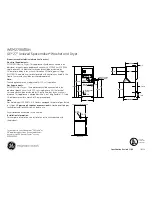
24
USER INSTRUCTIONS
25
EN
EN
20
• When using detergent tabs, place them in the cutlery basket. The dispenser
has been designed for powder or liquid detergent. As the cover does not open
completely during the washing cycle, tabs are not fully released (dissolved).
This could generate the following problems:
rinse cycle.
THE INTRODUCTION OF DETERGENT INTO THE RINSE AID DISPENSER,
EVEN IN LIQUID FORM, WILL DAMA GE THE DISHW ASHER.
General warnings and recommendations
recommendations concerning dish types to be washed and their loading. There
are generally no constraints on the washing of domestic dishes, but in certain
cases it is necessary to take their characteristics into account. Before loading the
dishes into the racks it is necessary to:
• soak any pots or pans with burnt-on food remains on the bottom to facilitate
removal, then load them into the LOWER RACK.
Use the “
” option (if available) for washing small amounts of dishes;
it saves water and electricity. When using this function, only load the rack se-
; the other rack must remain empty. There is no need
to pre-wash the dishes under running water before loading them into the racks
since this only wastes water. Correct loading of the dishes helps ensure opti-
.
s
t
l
u
s
e
r
g
n
i
h
s
a
w
l
a
m
WARNING!
•
ake sure that the dishes are securely in place so that they cannot tip over or
obstruct the rotation of the spray arms during the washing cycle;
• do not place very small objects in the racks as these could fall and obstruct the
spray arms or the wash pump;
• containers such as cups, bowls, glasses and pots should always be loaded with
the opening facing downwards and with any cavities at an angle, to allow the
water to drain out;
• do not stack dishes or place them in such a way that they cover one other;
• do not place glasses too close together because they may knock against each
other and break, or there might be staining at the point where they touch.
m
USER INSTRUCTION
5.3
EN
21
MAKE SURE that the items being washed are dishwasher-safe.
Items which are not dishwasher-safe:
•
Wooden dishes, pots or pans: these may be damaged by the high washing
temperatures.
• Handcrafted i tems: these a re r arely suitable for washing in a d ishwasher.
The relatively high water temperatures and the detergents used may damage
them.
• Lightweight objects: place lightweight objects in the upper rack where the
water pressure is lower.
• Dishes and objects in copper, tin, zinc or brass: these tend to stain.
• Aluminum dishes: items made from anodized aluminum may lose their col-
or.
• Silverware: silver items may stain.
• Glass and crystal: in general, glass and crystal objects can be washed in the
dishwasher. However, certain types of glass and crystal may become dull and
lose their clearness after many washings. Therefore, for these items we recom-
mend using the least aggressive program available (see “Description of con-
trols” manual).
• Decorated items: the decorated objects available on the market are generally
able to withstand washing in the dishwasher, although the colors may fade
after a great many washes. If in doubt as to the fastness of the colors, it is advis-
able to wash just a few items at a time for approximately one month.
USER INSTRUCTION
USER INSTRUCTIONS
EN
















































